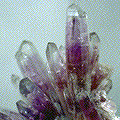English
Castellano
Català
Birthstones
Author: Memphis Archaeological and Geological Society
Content by courtesy of : Memphis Archaeological and Geological Society
Reproduction of text and photos prohibited without permission of author.
 January--Garnet
January--Garnet
Garnets are silicate minerals which occur in all colors except blue. The crystals can be found embedded and growing on the surface of gneiss, micaschists, eclogite, in calcareous and dolomitic metamorphic rocks, and frequently in sands. Garnets are rare in igneous rocks. Garnets are used as grinding and polishing agents as well as for gemstones. Almondine garnets are brown, red to violet, or black. Almondine is also known as carbuncle. Almondine can be found in Tyrol, Sweden, Urals, Ski Lanka, India, Scotland, Norway, Adirondacks, California, South Dakota, Michigan and Alabama. Andradite garnets are brown, black, green, yellow or colorless. Also known as Demontoid, Melanite, and Topazolite, these garnets can be found in Fichtelgebirge, Baden, Switzerland, and Austria. Grossularite garnets are grren, yellowish, brown, red, or colorless. Hessonite (cinnamin stone) is the brown-green variety. Leusogarnet is colorless, and Tsavolite is green. These garnets can be found in Hessen, Italy, Ski Lanka, Asbestos (Canada), Mexico, South Africa, Maine, New Hampshire, California, and Colorado. Cape rubies (Pyrope) are red in color and can be found in Saxony, South Africa, Australia, North Carolina, Arizona, and New Mexico. Spessartite garnets are yellow, orange or red brown. They can be found in Germany, Sweden, Madagascar, Sri Lanka, and Brazil. Emerald green Uvarorite garnets come from Finland, Russia, South Africa, and India.
 February--Amethyst
February--Amethyst
The violet colored macrocrystalline variety of quartz is Amethyst. The strongest shades of violet occur in the crystal terminations. Amethyst colors can fade. Heating might produce yellow, brown, green, and colorless tones. Amethysts can be found in Brazil, Uruguay, India, Madagascar, Montana and California.
 March--Aquamarine
March--Aquamarine
Aquamarine is the blue variety of beryl. Mostly long prisms, these beryl crystals can be found embedded and encrusted in pegmatite veins of granite rocks. Locations for Aquamarine include Brazil, Nigeria, Australia, Burma, India, and Sri Lanka.
 April--Diamond
April--Diamond
Diamonds can be found as embedded, octahedron, dodecahedron or cubic crystals. Colorless and fine diamonds are cut for gemstones. Only 20% of all diamonds are suitable for gemstones. The majority are used as industrial diamonds (bort) for drilling, cutting, and grinding tools. The value of a diamond is determined by its purity, color, cut, and weight. Diamonds occur in old volcanic vents, pipes or in placer deposits. The largest producers of gem diamonds are South Africa, Russia, Namibia, and Australia. The largest producers of industrial diamonds are Zaire, Russia, and South Africa.
 May--Emerald
May--Emerald
Emerald is the green variety of beryl. Mostly long prisms, these beryl crystals can be found in or close to pegmatite veins of granite rocks. Locations for Emerald include Columbia, Brazil, Zimbabwe, South Africa, and Austria.
 June--Pearl
June--Pearl
Pearls are produced by shellfish, mainly by oysters and mussels and more rarely by snails. They can be as large as pigeon eggs. They are constructed of lime carbonate (in the form of aragonite) and an organic horny substance called conchiolin. Pearls can be found in the Persian Gulf, off the southern coast of India, the northern coast of Australia, and the coast of Central America.
 July--Ruby
July--Ruby
Rubies, the red variety of corundum, occur in plutonic rocks, plutonic pegmatites and carbonate rocks as embedded tabular, short columnar, or barrel-shaped crystals. Rubies can be found in Upper Burma, Thailand, Sri Lanka, and Tanzania.
 August--Peridot
August--Peridot
Peridot or Chrysolite is the term used by the trade for the gem variety of olivine. In minerology, both names refer to olivine. Peridot is yellow green, olive green, or grennish brown in color. Peridot can be found in basic igneous rocks, in serpentinite and as a derived mineral in sands. Peridot can be found in volcanic island Zebirget--St. John (Red Sea), Mogok (Upper Burma), Queensland (Australia), Brazil, South Africa, San Carlos (Arizona) and Hawaii.
 September--Sapphire
September--Sapphire
Sapphires are all the gem-quality corundum except red (rubies). They occur in plutonic rocks, plutonic pegmatites and carbonate rocks as embedded tabular, short columnar, or barrel-shaped crystals. Sapphires can be found in blue, orange yellow (padparadscha), and colorless (leucosapphire) in Australia, Burma, Sri Lanka, and Thailand.
 October--Opal
October--Opal
Opal belongs to the quartz group. There are three varieties of opal: common opal, precious opal, and orange red fire opal. A special characteristic of precious opal is its rainbow-like iridescence which changes with the angle of observation. Precious opals with light or base colors are white opals. Precious opals with dark ground colors are black opals. Precious opals can be found in Australia, Brazil, Guatemala, Honduras, and Nevada. Fire opal shows no iridenscence, is usually milky, and only rarely transparent. Fire opals can be found in Mexico, Brazil, Guatemala, Honduras, and western Australia.
 November--Topaz
November--Topaz
Topaz appears as colorless, yellow, brown, blue, and green prismatic encrusted crystals in igneous rocks. Topaz can be found in Saxony, Brazil, Sri Lanka, Burma, pakistan, England, and Colorado.
 December--Turquoise
December--Turquoise
Sky blue or blue green prismatic Turquoise crystals are very rare. They appear as fine grained masses in sandstone fissures. Locations for Turquoise are Iran, Russia, Egypt, England, and the southwestern United States.
Information for this page derived from the Handbook of Rocks, Minerals & Gemstones by Walter Schumann, 1993
Content by courtesy of :
Information | Mineral photos | VIDEOS | Articles | Fairs | Web directory | Classified ads | Minerals Books | Shop



